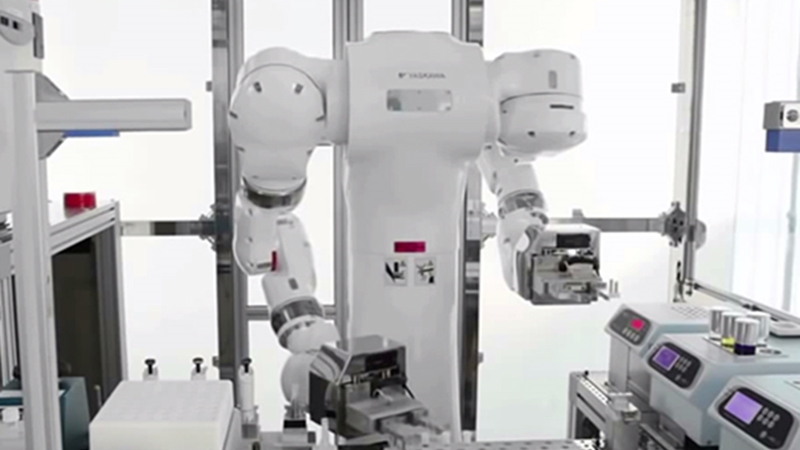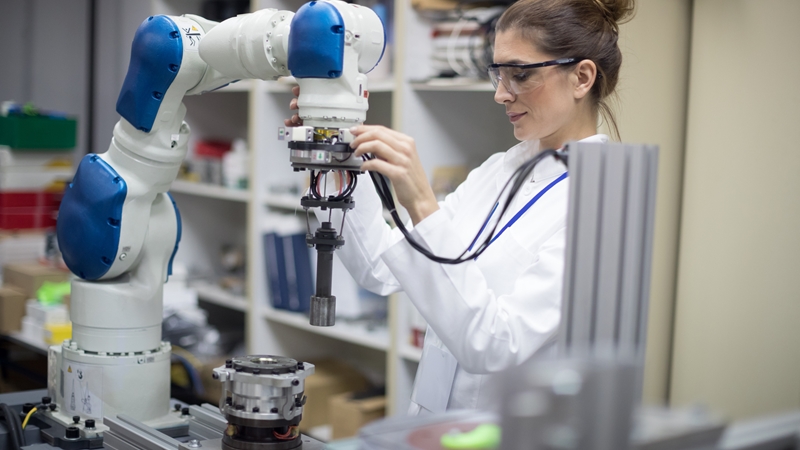With the recent boom of industrial robotics, one field has lagged behind – the pharmaceutical industry. This is unfortunate, as among other things robotics can help pharma companies reach the goal of continuous manufacturing. But what else have robotics got to offer?
Robotic technology has developed dramatically over the last decade and many industries have embraced it, from the automotive world to electronics. Finally, the healthcare industry is following suit, with many biotech pharma companies now exploring and developing continuous manufacturing processes, at least in the primary production steps. But this involves vessels and pipes – so what good can a robot do?
Robots and biotech - handling cell culture
Traditionally one of the first production steps in biotech is when the chemist handles the cell culture. This process requires a high level of sterility and takes place under a laminar flow hood to prevent contamination. The chemist must also wears gloves and goggles.
It is a critical production step with a high risk of cell contamination and requires a high level of accuracy - repeated in the same way every time. But despite the chemists's best efforts, unfortunately contamination does occasionally occur.
All of these parameters – repeatability, accuracy, sterility – can benefit from a robotic solution. Utilizing robots removes a key element we can't avoid with people - human error. Robots execute the process with a very high level of accuracy and duplicate that accuracy repeatedly.
In addition, they can work in a fully closed and sterile environment. In fact, several robot vendors have already approved robots for clean room class A and labelled them suitable for decontamination processes in vaporized hydrogen peroxide (VHP) environments.
Robotics and bulk flask filling
One of the final steps in the biotech process is often "bulk flask filling", which again has high requirements for repeatability, accuracy and sterility. Robots can execute this process, fulfilling these specifications and tapping into the benefits below:
- Removes need for gowning and all of the related processes around washing and transport.
- No need to read standard operating procedures (SOPs) or receive regular training.
- Can operate under poor working conditions and in strange positions, without compromising any health, safety or environmental regulations.
- Can switch between several programs, offering a high degree of flexibility.
Furthermore, a robot can be equipped with a camera and document significant production steps where needed. But perhaps one of the greatest advantages of utilizing robotics in this area is that it releases chemists from monotonous work, allowing them to concentrate on more worthwhile tasks in the cell culture process.
Beyond biotech: How robotics can contribute to the goal of continuous manufacturing
The benefits listed above can reach further than biotech, and there are many other areas where robotics can contribute to the goal of continuous manufacturing. For example:
- The ability of robots to take samples from the process and transport them to quality control (where process analytical technology (PAT) instruments take over and perform the analysis online, providing feedback to the control systems).
- They can lift and empty large bags safely. In oral solid dosage (OSD) facilities, handling powder bags generates a great deal of dust, and often operators have to wear protective gowning. Instead, utilizing a robot would remove this dust exposure risk.
- Robots can load and unload materials to machines. Finished pharma facilities have several load and unload requirements, and often transport materials to and from production equipment. By allowing a robot to unload the filling machine and automatically transport it to inspection or freeze-drying, the production could be made continuous from filling to inspection.
Integrating robotics into the pharma manufacturing industry
Robotic technology is widely used in other industries, some of which are comparable to pharma. In the automotive and electronics industry cost is vital, requirements for cleanliness are higher than pharma and the need for agility and flexibility is key for survival.
Furthermore, the US Food and Drug Administration (FDA) encourages the adoption of innovative approaches to pharmaceutical product design and manufacturing. In fact, the FDA has established the Emerging Technology Team (ETT) so industry representatives can meet with ETT members to discuss, identify and resolve potential concerns regarding the development and implementation of a novel technology prior to filing a regulatory submission.
So, the technology is here. Peers have used it for decades and the regulatory authorities are encouraging the pharma world to embrace robotics. What are we waiting for?


